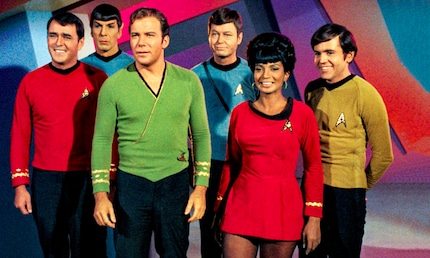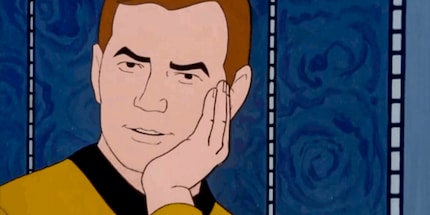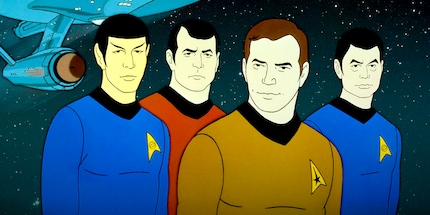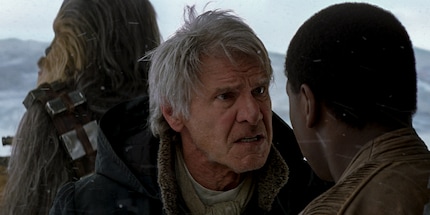
Background information
Mary Sue, part 2: what about Luke Skywalker?
by Luca Fontana

Without weaknesses, strong and loved by everyone – except by fans. But who is Mary Sue? Or should we ask: what is a Mary Sue? Let’s find out.
Humans love good stories. They make us forget our boring everyday life in an instant. But writing a good story is a difficult art. It starts with the most important of all questions for every storyteller:
who’s my main character?
I’m not talking about name, age or place of birth. I mean characteristics and traits. Preferences and habits. Strengths. Weaknesses. These kinds of things. They make a character come alive and make him or her seem real and relatable. They make you believe this person actually exists and isn’t just a clever invention of a modest author – or worse: a self-fulfilling, idealised projection of yourself.
That’s what a Mary Sue is.
You've probably come across Mary Sue in forums and «how to movie» blogs on YouTube. Or in my story about MacGuffins, where reader JTR.ch commented:
Now talk about what a Mary Sue is – it’s easy enough if you refer to the last few Star Wars movies.
It’s true that «Star Wars: The Force Awakens» gave rise to the discussions about Mary Sue. Rey, the main protagonist, being a Mary Sue is one of the most frequently mentioned accusations surrounding the movie.
Indeed, Rey does appear to meet the criteria of a Mary Sue.
So, Mary Sue isn’t a person. Mary Sue is a concept. It represents a character who is morally perfect and is immediately loved by all other characters. Mary Sue masters every challenge without a problem. She’s the best and most intelligent in every group, without ever being explained why. She learns new skills in a flash. She has no weaknesses. And if so, they add to her likeability. That's why a Mary Sue’s character development remains static.
That's not only boring, it’s also charmless.
That’s there was so much resentment towards Rey, a simple but pretty scavenger. In the movie, everybody likes her. After all, she's great and can do everything: she’s so good with her quarterstaff that later she even stands up to the experienced Kylo Ren – who has a lightsaber. She also repairs the Millennium Falcon, although she’s a scavenger, not a space ship mechanic. Oh and she’s also a space ship pilot who performs flight manoeuvres – without co-pilot – that would even impress Han Solo. She knows how to use mind tricks as soon as she has her first vision; the poor storm trooper. Even Kylo Ren can’t break Rey. And she frees herself from captivity:
In other words, Rey’s character is defined by her superior abilities, never by weaknesses or defeats that she has to overcome in order to grow. This makes her so unrealistically perfect that she doesn’t seem real.
Such Mary Sue characters often appear in films and books – mostly as an idealised version of the author himself or herself. It’s a self-projection, so to speak, the fulfilment of a dream. Accordingly, «Mary Sue» originates from fan fiction.
More precisely: Star Trek fan fiction.
It's 1966. NBC's new science fiction series is exciting but controversial. In a time of racist tensions, «Star Trek: The Original Series» shows a positive image of humans where different races, genders and cultures – not to mention aliens – work together in a constructive way. For that time, this was a utopian vision.

The show had fans. Just not many. «Star Trek» was scheduled to end after just two seasons. What followed might be the first shitstorm in TV history: around one million protest letters arrived at the station and demanded the series to continue.
NBC gave in. A third season followed. But then the show ended. At that point, die-hard fans didn’t know that the franchise would be revived ten years later as a feature film. They fill the vacuum left by «Star Trek» with their own stories.
Fan fiction.
The new stories were read. And shared. In fanzines, non-professional fan magazines written from fans for fans. They quickly gain momentum. A cult is born. Female authors in particular imagine stories with a protagonist that they imagine to be themselves. Often as young female cadets whose superhuman talent makes them captains of the Enterprise in no time, while they charm the crew.
One Star Trek fan is especially annoyed by this: Paula Smith.
In 1973, she took all the clichés and wrapped them up in a parody that couldn’t be more grotesque: «A Trekkie’s Tale». It’s published in the fanzine «Menagerie», issue 2, page 6.
The protagonist of this curious piece was Mary Sue.
«Gee, golly, gosh, gloriosky,» thought Mary Sue as she stepped on the bridge of the Enterprise. «Here I am, the youngest lieutenant in the fleet – only fifteen and a half years old.»
Captain Kirk came up to her. «Oh, Lieutenant, I love you madly. Will you come to bed with me?»
«Captain! I am not that kind of girl!»
«You're right, and I respect you for it. Here, take over the ship for a minute while I go get some coffee for us.»

Mr. Spock came onto the bridge. «What are you doing in the command seat, Lieutenant?»
«The Captain told me to.»
«Flawlessly logical. I admire your mind.»
Captain Kirk, Mr. Spock, Dr. McCoy and Mr. Scott beamed down with Lt. Mary Sue to Rigel XXXVII. They were attacked by green androids and thrown into prison. In a moment of weakness Lt. Mary Sue revealed to Mr. Spock that she too was half Vulcan. Recovering quickly, she sprung the lock with her hairpin and they all got away back to the ship.
But back on board, Dr. McCoy and Lt. Mary Sue found out that the men who had beamed down were seriously stricken by the jumping cold robbies, Mary Sue less so. While the four officers languished in Sick Bay, Lt. Mary Sue ran the ship, and ran it so well she received the Nobel Peace Prize, the Vulcan Order of Gallantry and the Tralfamadorian Order of Good Guyhood.

However the disease finally got to her and she fell fatally ill. In the Sick Bay as she breathed her last, she was surrounded by Captain Kirk, Mr. Spock, Dr. McCoy, and Mr. Scott, all weeping unashamedly at the loss of her beautiful youth and youthful beauty, intelligence, capability and all around niceness. Even to this day her birthday is a national holiday of the Enterprise.
The end.
By the way, the term Mary Sue is often used for both genders. If you want to distinguish a male from a female character, use Mary Sue or Gary Stu.
All right, so a Mary Sue character destroys the story. Always. So «Star Wars: The Force Awakens» is terrible?
Yes and no.
A Mary Sue character is a problem if he or she is the epicentre of the plot. If everything that happens revolves around this character and there is no room for other, more exciting characters.
Rey isn’t the centre of attention in «The Force Awakens». It's the search for Luke Skywalker and the threat to the Starkiller Base that forces our heroes to act. And it’s the emblematic search for the lost son that leads the aging legend Han Solo to join Rey and Finn, the deserted storm trooper, into the Lion's Den.

With this in mind, one could even argue that Rey isn’t a Mary Sue after all, but at worst a badly written and uninteresting character. But that alone doesn’t make «The Force Awakens» a bad movie.
So is the Mary Sue problem not a character problem, but a storytelling problem?
I like the idea. It means that Mary Sue characters aren't at bad in general or badly written characters. It’s all about how they’re used in the story.
Want an example?
In the 1964 «Mary Poppins», the British nanny describes herself as «practically perfect in every way». A storybook Mary Sue. But in the Disney movie, she doesn’t upstage the other characters. On the contrary. The film isn’t about how great she is, but about the influence of her greatness on others. Poppin's lessons for life don’t only help the children grow, but also – and this is the main plot – the father, Mr. Banks.
A completely different example: Bella Swan from «Twilight».
Apparently, she looks a lot like the author of the books. Bella is described as average looking. In theory. But the boys around her act as if she was the prettiest girl in school. Wish fulfilment. Remember? I mean, everybody falls in love with Bella. Not just Edward and Jacob, but also Mike, Eric and Tyler. Her only weakness? Clumsiness. But that’s kind of cute, right?
The plot? It could be about the ancient conflict between werewolves and vampires. But it's really all about Bella. About Bella and her guys, who happen to be werewolves and vampires. At least in the first movie. I haven't seen the others. And I haven’t read any of the books. So feel free to correct me.
So what’s the problem with «Twilight»? The yearning character of Bella or the yearning character of Bella in a story that doesn't offer anything else but the yearning character of Bella? Probably the latter.
That’s exactly what I mean when I say «Mary Sue» is a storytelling problem, not a character problem. The assumption often made in discussion forums and YouTube vlogs that a story is generally bad if its main character is a Mary Sue is, in my opinion, far too simplified.
Let's summarise: a Mary Sue is a character that, without giving any reasons, is perfect, impeccable and loved by everyone in every respect. May Sue characters don’t develop. And often, they’re projected fantasies of their authors.
Does that explain the Mary Sue problem? Not quite. That's not the whole story.
A movie is only ruined if the entire plot revolves around the Mary Sue character, downgrading side characters to extras who are only there to witness the magnificence of the Mary Sue character. Remember the comparison between «Mary Poppins» and «Twilight».
If we follow this line of argument, we come to the conclusion that what annoys us about Mary Sues isn’t the result of a badly written character, but the result of poor storytelling that focuses too much on the uninteresting Mary Sue character. This takes us back to the beginning:
humans love good stories.
I write about technology as if it were cinema, and about films as if they were real life. Between bits and blockbusters, I’m after stories that move people, not just generate clicks. And yes – sometimes I listen to film scores louder than I probably should.
Interesting facts about products, behind-the-scenes looks at manufacturers and deep-dives on interesting people.
Show all